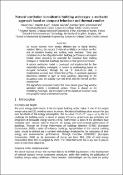Options
Natural ventilation in residential building archetypes: a stochastic approach based on occupant behaviour and thermal comfort
Date Issued
2014-05-10
Date Available
2016-11-21T15:36:52Z
Abstract
As houses become more energy efficient due to highly thermal resistant fabrics, the impact of natural ventilation on indoor comfort and on transient heating and cooling loads increases. These two constraints must be integrated within building performance simulation models when assessing the potential for electrical load shifting strategies in residential buildings placed in a smart grid environment. A natural ventilation model is developed and implemented for five residential building archetypes. A bottom-up methodology based on occupant behaviour, through the use of time-of-use data, is implemented at room level within EnergyPlus. A stochastic approach determines whether to open or close windows, depending on the occupancy state, the activity type and level, and the thermal comfort experienced. The algorithms proposed consider the main drivers governing window operation within a residential context. Focus is placed on the modelling challenges, and the impacts of the model are assessed using energy performance and thermal comfort.
Sponsorship
Science Foundation Ireland
Type of Material
Conference Publication
Publisher
International Building Performance Simulation Association (IBPSA)
Web versions
Language
English
Status of Item
Not peer reviewed
Conference Details
IBPSA-Canada eSim Conference: Removing barriers to application of Building Performance Simulation in design practice, Ottawa, Canada, 07-10 May 2014
This item is made available under a Creative Commons License
File(s)
Loading...
Name
Natural_Ventilation_in_Residential_Buildings.pdf
Size
426.72 KB
Format
Adobe PDF
Checksum (MD5)
a6cdec2cd210f8c296b3459ca5fb8bc6
Owning collection